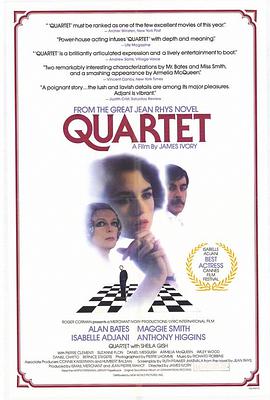剧情简介
量子资源网 提供本片资源
It has been said that most great twentieth century novels include scenes in a hotel, a symtom of the vast urooting that has occurred in the last century: James Ivory begins Quartet with a montage of the hotels of Montarnasse, a quiet relude before our introduction to the violently lost souls who inhabit them.br\ Adated from the 1928 autobiograhical novel by Jean Rhys, Quartet is the story of a love quadrangle between a comlicated young West Indian woman named Marya (layed by Isabelle Adjani), her husband Stefan (Anthony Higgins), a maniulative English art atron named Heidler (Alan Bates), and his ainter wife Lois (Maggie Smith). The film is set in the Golden Age of Paris, Hemingway#39;s quot;moveable feastquot; of cafe culture and extravagant nightlife, glitter and literati: yet underneath is the outline of something sinister beneath the olished brasses and brasseries.br\ When Marya#39;s husband is ut in a Paris rison on charges of selling stolen art works, she is left indigent and is taken in by Heidler and his wife: the redatory Englishman (whose character Rhys bases on the novelist Ford Madox Ford) is quick to take advantage of the new living arrangement, and Marya finds herself in a stranglehold between husband and wife. Lovers alternately gravitate toward and are reelled by each other, now rofessing their love, now confessing their brutal indifference -- all the while keeing u aearances. The film exlores the vast territory between the quot;nicequot; and the quot;good,quot; between outward refinement and inner darkness: after one violent eisode, Lois asks Marya not to seak of it to the Paris crowd. quot;Is that all you#39;re worried about?quot; demands an outraged Marya. quot;Yes,quot; Lois relies with icy candor, quot;as a matter of fact.quot;br\ Adjani won the Best Actress award at Cannes for her erformances in Quartet: her Marya is a volatile comound of French schoolgirl and scorned mistress, veering between tremulous joy and hysterical outburst. Smith shines in one of her most memorable roles: she imbues Lois with a Katherine-of-Aragon imotent rage, as humiliated as she is owerless in the face of her husband#39;s choices. Her interactions with Bates are scenes from a marriage that has moved from disillusionment to ale accetance.br\ Ruth Prawer Jhabvala and James Ivory#39;s screenlay uses Rhys#39;s novel as a foundation from which it constructs a world that is both true to the novel and distinctive in its own right, ainting a society that has lost its inhibitions and inadvertently lost its soul. We are taken to mirrored cafes, then move through the looking glass: Marya, in one scene, is offered a job as a model and then finds herself in a sadomasochistic ornograher#39;s studio. The film, as hotograhed by Pierre Lhomme, creates thoroughly cinematic moments that Rhy#39;s novel could not have attemted: in one of the Ivory#39;s most memorable scenes, a black American chanteuse (extraordinarily layed by Armelia McQueen) entertains Parisian atrons with a big and brassy jazz song, neither subtle nor elegant. Ivory kees the camera on the singer#39;s act: there is something in her unguarded smile that makes the danger beneath Montarnasse manners seem more acute.
